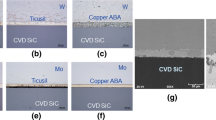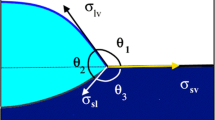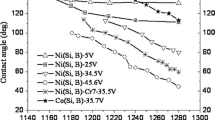Optimized processes for obtaining the braze-welded joints of oxide ceramics based on Al2O3 and ZrO2 by pressure welding of ceramics with ceramics and ceramics with metals are developed. It is established that these braze-welded joints are prepared in the 1300–1600°C temperature range with pressure holding for 30–120 min under 15–25 MPa. The samples of welded pilot products that can be operated in both neutral and protective environment (up to 1500–1800°C) are produced according to the processes developed.



Similar content being viewed by others
References
J. J. Stephens and K. S. Weil, “Brazing and Soldering 2006,” in: Proc. 3rd Int. Brazing and Soldering Conf. (24–26 April 2006, San-Antonio, Texas, USA), ASM Int., San-Antonio (2006), pp. 44–53.
Yu. V. Naidich, V. S. Zhuravlev, I. I. Gab, et al., “Liquid metal wettability and advanced ceramic brazing,” J. Europ. Ceram. Soc., 28, 717–728 (2008).
I. I. Gab, Pressure Brazing in Solid Phase in: Inorganic materials science, materials and technologies [in Russian], G. G. Gnesina and V. V. Skorokhod (Eds.), Vol. 2, Book 2, Nauk. Dumka, Kiev (2008), pp. 15–23.
N. Eustathopoulos, “High Temperature Capillarity’94,” in: Rev. Proc. 1 st Int. Conf. (8–11 May 1994, Bratislava, Slovakia), Institute of Inorganic Chemistry Slovak Academy of Science, Bratislava (1994), pp. 123–128.
R. V. Allen and W. E. Borbidge, “Solid state metal-ceramic bonding of platinum to alumina,” J. Mat. Sci., 18, No. 9, 2835–2843 (1983).
G. Christensen and K. Gotthjaelp, “Diffusion bonded joints in alumina and PS-zirconias with excellent thermo-shock and mechanical properties,” DVS-Ber., 148, 187–189 (1992).
M. L. Shalz, B. J. Dalgleish, A. P. Tomsia, et al., “Ceramic joining III. Bonding of alumina via Cu–Nb–Cu interlayers,” J. Mater. Sci., 29, No. 14, 3678–3690 (1994).
R. A. Marks, J. D. Sugar, and A. M. Glaeser, “Ceramic joining IV. Effects of processing conditions on the properties of alumina joined via Cu–Nb–Cu interlayers,” J. Mater. Sci., 36, No. 23, 5609–5624 (2001).
R. A. Marks, D. R. Chapmen, D. T. Danielson, et al., Joining of alumina via copper/niobium/copper interlayers,” Acta Mater., 48, Nos. 18–19, 4425–4438 (2000).
Author information
Authors and Affiliations
Corresponding author
Additional information
Translated from Poroshkovaya Metallurgiya, Vol. 55, Nos. 7–8 (510), pp. 93–97, 2016.
Rights and permissions
About this article
Cite this article
Naidich, Y.V., Gab, I.I. & Stetsyuk, T.V. Brazing Oxide Ceramics via the Ductile Interlayers of Niobium and Noble Metals. Powder Metall Met Ceram 55, 454–457 (2016). https://doi.org/10.1007/s11106-016-9826-8
Received:
Published:
Issue Date:
DOI: https://doi.org/10.1007/s11106-016-9826-8




